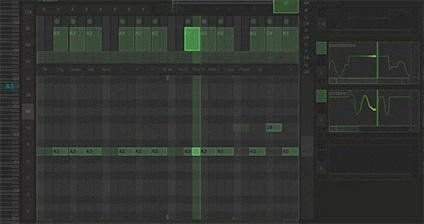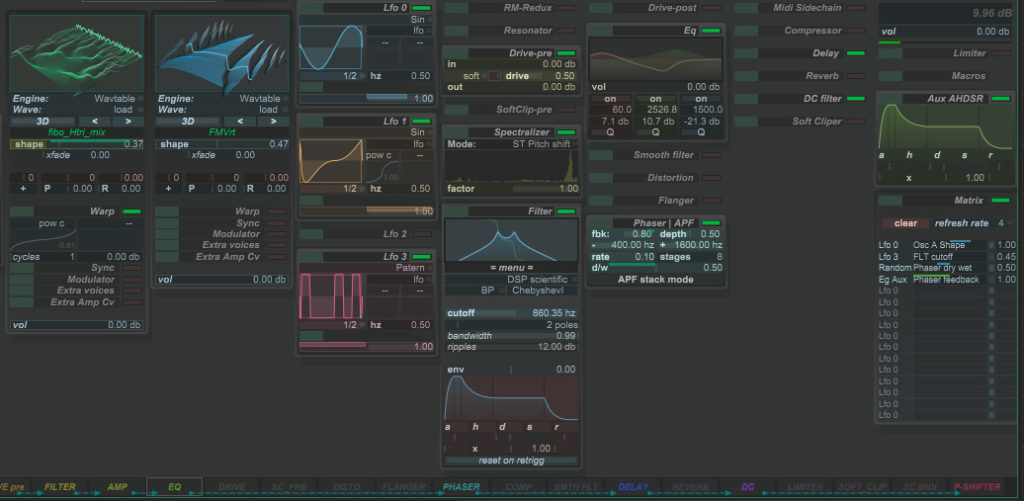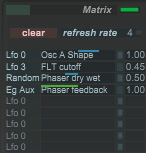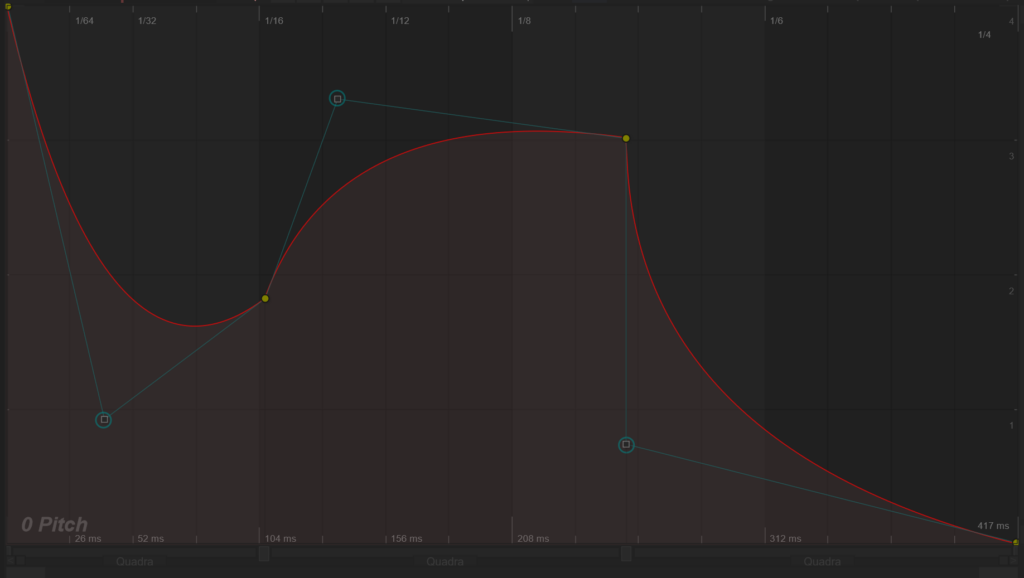
Psylab Pro is a vsti plugin and standalone app dedicaced to advanced kick bass designs. its core concept is build on unique TRUE cubic bezier curves system engine.
Its not a « simple » kick synth, neither a « traditional » synth, it’s like an « hybrid » of both.
It was initially especially designed for my personal psytrance kick and bass design applications, hence the name « psylab » , i was not happy with existing limitations on others vsts, and none of them used (and none still uses..) true cubic beziers but simplified quadratic versions.. in the best case..
..so i decided to build my own true bezier kick synth. but it can do much, much more now and fit any electronic genre really…
wtf is a cubic bezier

unlike quadratic, true cubic beziers allow to shape both the in and out slopes of a segment independently, and have a smooth continuity from prev to next segment. (Professional gfx, 3D and animation software all use cubic beziers since years, for their « superior » precision)
As a vfx artist myself I always thought audio software should too and didn’t understand why..
Audio Software always went quadratic sadly for computation reasons… But today computers have evolved a lot and now can handle real time cubic bezier at audio rate.
Psylab is one of the few, if not only one that can do both quadratic and cubic bezier versions.
Curves can control any parameter via drag n drop, be lfo shapes , or even oscillator shapes
If wanna have total shaping control, go deep on sound design, psylab got features unmatched yet by any other « kick » synth on the market. Can control more than 300 sounds parameters via up to 64x sample accurate Cubic Beziers custom curves, 16x lfos, 16x AHDSR eg, seq lanes.., 4x independant parts layers, each powered by 2x flexible oscillators, including synthesis engines like maths dsp /noises /wavtable / additive / FFT /samplers, / and unique to psylab bezier waves oscilators.. per program. a powerfull multi-track scope, ref kick re-synth engines, phase aligment and keytracking tools…
PsyLab custom cubic bezier oscillators, with mix and morph to wavtable ability
Moreover unlike other softwares, psylab kicks are not static ‘pre-cached’, they are dynamically rendered, real time generated, means can have for ex lfos, curves, modulators over any duration, even 8 bars making any of the 20+ fx, or osc parameters evolve over long period of time, not limited to just the kick duration itself.
But…..
this comes at a cost.. this is not a one knob synth. can use out of the box presets but tbh thats not the goal.
Psylab goal is stimulate reseach, sound design, giving user tools and power to overcome usual limits i pers faced over years, avoid classic ‘basic’ paths traps, but really ‘work’ explore ,and shape deeply
your own sound .
So be aware there IS a learning curve. but if you are curious and ready for that, you ll quickly realize it open unparallled possibilities as a reward.
Wav Rasterizer: Psylab can also vectorize any sample ie bass to bézier curve for custom wav edits
New 1.3 ui
Psylab was the very first kick synth to automatically extract amp and pitch cv from a ref kck a few years back in 2020. It always had focus on opening new and unconventional ways of shaping sound with very deep control if needed.
Next gen 1.3 got its re-synth engine upgraded for new modular layers splitting abilities, with high accuracy, for a minimal number of points, and some new powerful re-vectorize engine to simplify curves nb of points. Some new poly and stereo modes..
(below some wips for 1.3 kbb and other sounds presets in the writing)
as you ll discover with psylab, it is also far from being only limited to « kicks » or bass, the variety of synthesis engines makes it can virtually do any kind of sound..
New in 1.3.0:
_Direct2D Hardware Gpu acceleleration
-Dual view, curves and params
_Automatic Kick n Bass Phase n Keytrack align
_Re-synth references kicks with layers splits
_Sampler loop points / Vectorize any sample to bezier with loop points
_ Pan, stereo, poly parts modes,
_Audio in oscillator, (route any ext vst in psylab, use sidechain, phase kbb, fx…)
and more…
playlist shows wip sneak peaks:
Psylab 1.3 WIP vids
Older original psylab v1.0
psy kbb presets of the 1.0
audio demo of other sound types presets wip
Downloads:
Current Build:
Available as VST 2.4 – 64bits – dll, VST3 and Stand-Alone app for Windows
Public Beta demo:
Demo Limitations:
- Limited to one instance
- Saving of presets is disabled
- Wav export and drag n drop to daw is disabled
- No multi output
Full Version:
Full version without limitations requires a license that can be purchased at Gumroad Inc website linked here.
Users Area:
Login to your user account to retrieve latest installer and license files.
This product is for WINDOWS only,
NOT for MAC !
System Recommendations:
- modern i5-i7-i9 or AMD Ryzen cpu
- 8Gb ram with at least 256 mb free
- 100mb free hard drive space.
- 64 bits VST host
- Windows 10-11 x64
- 32-2048 samples asio buffer size
- 1280×720 min screen resolution

Advanced Curve System
Versatile, tight and precise unique curves system. Each curve is built from procedural segments including linear, steps, sinus, hermite or cubic splines, quadratic and true cubic béziers modes...
In professional 3D animation/video hi-end softwares, there is always a powerful « animation editor », linked to the timeline, which defines curves set-up by « key-frames » to drive animated parameters.
Industry standard for those curves is using cubic béziers , because they are the most versatile in terms of precision and possible output shapes.
True cubic beziers offer 2x tangents, that are XY movable, allowing to control both in and out slopes, while preserving (or not.., at will..) a smooth continuity from a segment to the next. Resulting possibilities go way beyond traditional found in audio software « linear » curves, which are in best case usually only « roundable » via a single one dimension parameter at the center.
Psylab was built around the integration of this system at its core.

Main idea was to be able to drive audio events « animations », same way it’s done for parameters in vfx, with sample accurate, ultra tight, hi def bezier curves to contol a wide range of aspects of the sound over time, ie amplitude, frequency, oscillators shapes, filter, distort amount ect.. with ultimate precision. Psylab Curve Editor is large, fast and responsive, can be zoomed and scrolled, with a lot of dedicaced tools for precise editing and manipulating of the 16x curves.
Its also based on a WYSIWYG system, with drawn synced sound waveform under the currently edited curve.
While cubic bezier was most wanted initial goal, psylab also has +15 others different ‘segments modes’ which are lower on cpu (ie simpler quadratic bezier, with only one tangent, linear, steps, splines or sinus modes, depending on what wanna achieve, more traditional basic pow/log ect..), which can be set individually, per segment.

Each curve can be stored as preset / recalled / Init / Copy-Pasted. A wide range of processing options are available like scale, reverse, double size, randomize, shift/roll, ect.. A shape generator easy generates say 32 random steps, perfect beziers sinus ,tri, saws, squares ect… with control points true morphing ability.
This allows design of very complex and precise curves in a way that remains unmatched yet in other traditional or much more expensive hi-end vst synthesizers.
It’s also possible to directly drag n drop procedural shape presets on individual segments for faster workflow.



Build-in Synced Oscilloscope
Easy inspect waves, peaks, phasing, KB overlap areas.. Display current sound or reference file wave under the curves. From 8 bars to sample rez, all with Zoom n' Scroll.

On top of the interface, main oscilloscope shows the result of the output summing, always perfectly in sync with the grid. ie if set on 1/4 it will re-trigger each kick and will display the kbb. Can then zoom and scroll inside the buffer, up to sample rez.
it can be displayed in any context (curve editor, params menu..) or hidden to give more room to parameters or curves editing.

A multi-Layer mode shows individual sounds layered. Useful to perfectly tune / phase align (or not!) elements or samples.

Can display spectrum and spectrogram.
 At any time its possible to bounce oscilloscope content via a single click, then direct drag and drop new made .wav file to the daw.
At any time its possible to bounce oscilloscope content via a single click, then direct drag and drop new made .wav file to the daw.
A second mode can display current sound note buffer only. Auto button will scan max peak to auto-fit and use maximum display area, (like a ‘display normalize’).
Current sound note can also be displayed in curve editor background, so can see how the curve tweaks affect the wave real time, with 1:1 timing perfect match and synced zoom n scroll.
An optional reference wav can also be loaded (ie a kick to inspire from) and both current and ref waveforms can be then easily compared, zoomed/scrolled in sync in a very convenient way.
Multi-Engines Generators
Classic, Bezier, Noizes-Paterns, Wavtable, Cycler, Sampler, Additive...
Each one of the 4 parts got 2x versatile generators.
Each generator provides 7 generative modes and is made to receive some more in the future.

Currently included engines:
*Classic: traditional sin, tri, saw, square and several more ‘math’ shapes with various shaping flavors.
*Bezier: custom user curve, with unique beziers control points true morph system from a curve to another.
*Noise – Patterns: various flavors of noises and procedural patterns/sequences like white, pink, brown ,hiss,crakles,MLS,,SH…
*Wavtable: hi quality bi-cubic 2048 samples per cycle / 256 tables, with 2d or 3d overview.

*Sampler: allows to layer one shots vavs, ie add HH or other attacks or custom sounds on top of kicks.
*Cycler: creates one cycle from wavs parts wich can give interesting harmonic rich content ie for buzzy /fm-ish type leads.
—–(Ability to load custom user .wavs for all wavtable, cycler and sampler engines)—-.
*Additive: fourrier engine allowing to edit bins via bezier curve ( will be developped further in future releases.)

A powerful Warp engine allows to remap/distort phase and/or amplitude via +40 different procedural functions.. available both for osc and lfos engines.
Each generator can have a modulator engaged for AM, RM, PM, PWM, FM, phase and amp distortion.
3x extra voices can be set with independent phase, pitch and volume. ie boost cancel some harmonics.


Build-in Sequencer
Sound design is also about time. Easy build/save/recall/test/randomize different patterns within sound patch. Export to midi file with direct drag n drop to daw clips.
Each part can of course receive midi from daw, but also has it own build in pattern sequencer.
This allows to quickly set ie, a 4/4 kick and a bass patern and save it within the preset.
So on reloading a patch have instant overview without messing to re-find what was
midi associated with, or make tailor sound designs for particular set of sequences.
8x playground patterns, that can be ordered with a chainor.
Its also convenient to design in standalone without need of a daw, then later re-use patches in vst version.

Its made as an hybrid step/clip , with handled separately triggers, gate length, velocities and
pianoroll. This allows ie to keep same notes, but randomize triggers or gates only,
or quickly generate random patterns for inspiration (can choose only a set of notes).
Pattern notes can be saved to midi file and directly drag and dropped ie to an ableton midi clip from the plugin interface.

8x lanes can record and remote chosen sound patch parameters movements.
All sequencer data can be stored/recalled to ‘SEQ’ presets. ie quickly test variations of kick bass with already saved presets.
Versatile Filter
40+ Filter types including LP, HP, BP, Band Stop, Allpass, Notch, Lo/Hi shelves, In Biquad, Butterworth, Chebyshev, Elliptic, Bessel, Legendre, Moog , Korg, Oberheim Emus, Formants and other designs… most from 1 to 12 poles, with frequency and phase response overview.
Adjust Filter envelope with ultimate precision/shaping via user bezier curve, or dynamic AHDSR.
Lfos, Sequencer, Velocity and keytrack weights.
Display Frequency response and Phase response.
Affect phase only ie via Allpass mode.
from 1 up to 12 poles for precise custom response.

Flexible routing and Matrix
20+ Fx processor can be chained and ordered as wish. powerfull matrix with +50 sources and +350 destinations parameters
![]()
Put distorsion before or after filter, VCA after/before FXs, flexible routing via simple drag and re-order processors chain.
Matrix can pick any of 50 sources (4x macros, 4x lfos, 16x custom curves, 4xAHDSR, randoms, vel, gates, audio..) to +350 parameters destinations.

Features:
* 4x parts multi-timbral monophonic synthesizer.
* 4x separated midi-in & 4x audio outputs if wanna split.
* Full vector resizable Ui, fast and responsive, with lot of visual feedback.
* Ultra fast preset switching / compare system.
* Foldable parameter’s groups. Display only a reduced to ‘only wanted’ set, or have control on everything.
* Built in synced oscilloscope for precise overview (ie Kick bass phasing), with zoom and scroll, from 8 bars up to sample rez.
* Advanced curves system and editor (16x vector user curves with: true cubic beziers, quadratic beziers, cubic splines, hermite splines, steps, linear, sinus, and more … independent segment’s types controlling various sound aspects like amp, freq, osc shapes, phases, filter, morphing ect.. ).
* Ultra tight and stable/consistent sample accurate midi and envelopes timings.
* 2x versatile generators per part with classic, bezier, noizes-paterns, wavtables, sampler, cycler & additive fourrier engines.
* Hi quality bi-cubic wavtable/cycler/sampler engines modes, with custom user .wav load ability.
* Independent modulator per oscillator.
* AM, PM, FM, RM, PWM, SYNC, phase and amplitude distortion, wich can all be cumulated.
* 3x sub oscillators voices per osc with independent phase, vol , pitch controls, ie cancel/boost fundamental.
* 2x versatiles LFOs with wide range of sources modes,
including user beziers.
* 40+ modifiers/warpers types that can be applied on phase and/or amplitude of both osc and lfos.
* 40+ Filters type including LP, HP, BP, BS, Allpass, Lo/Hi shelves,
Incuding Biquad, Butterworth, Chebyshev, Elliptic, Bessel, Legendre, Moog , Korg, Oberheim Emus, Formants…
most from 1 to 12 poles, with frequency and phase response overview.
* Custom curves choice for amplitude / pitch / filter, or dynamic AHDSR envelopes.
* Fx: delay, disto, reverb, flanger, phaser, compressor, ring modulation, soft cliper, bit -rate reducer, karplus strong resonator, limiter, custom user curve based wavshaping, multi-modes drive, eq…
* Load reference wav files with wavform display, automatically extracts pitch and amplitude enveloppes for easy copy / use as starting point ie to clone a kick, easy toggle ref/current.
* Approximate true ref wavform itself with bezier function.
* Instant Midi sidechain with precise custom user bezier curve ducking.
* A-B memory slots for comparing different patch settings.
* Build in bounce sound to wav file with direct drag n drop to daw.
* Build in sequencer with drag and drop Midi patern to daw.
* Build in converter helper (samples to ms, hz, beat, note names, tempo to delay ect.. ).
* Unique bezier morph system for true morph from user osc shape to another.
* Up to 16x oversampling.
..more in cooking for future releases..
Tutorials:
Here find quick tours in .en and .fr. and more specific tutorials.
And can check youtube channel for more tutorials / updates infos ect:
FX23 vst playlist
How to: sequence from daw

Select sound wanna remote, go to sequencer tab and switch it off via the on off button. Or to completely disable all internal sequencers go to about tab and tick « disable sequencer in vst » option.
Then create a new midi track for each sound wanna individually remote from daw and route its midi output to corresponding midi input on the plugin.
(refer to your daw manual).
If having pro version you can also route each audio individual outputs.




